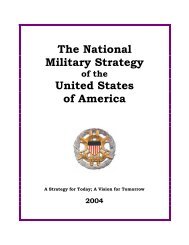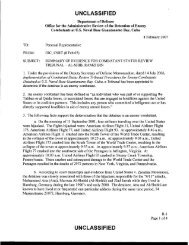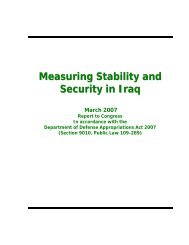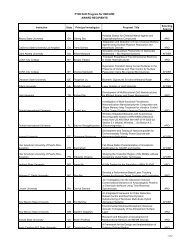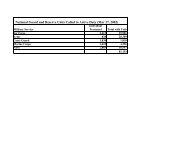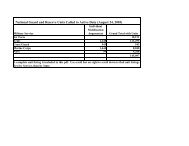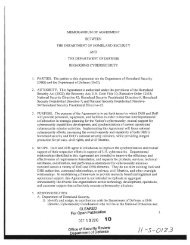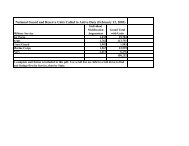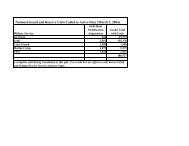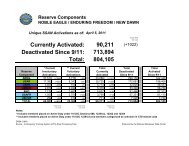Report - United States Department of Defense
Report - United States Department of Defense
Report - United States Department of Defense
You also want an ePaper? Increase the reach of your titles
YUMPU automatically turns print PDFs into web optimized ePapers that Google loves.
UNCLASSIFIED<br />
initial bi-lateral partnering arrangements and are now capable <strong>of</strong> leading operations that are<br />
advised by ISAF. They provide a national response tackling the terrorist, insurgent and narcotic<br />
threats that GIRoA faces. The 19 provincial response companies (PRCs), as the name indicates,<br />
are provincially based Special Police units that specialize in civil order security and high-risk<br />
arrests and partner with ISAF SOF for training and operations. The closer integration <strong>of</strong><br />
Intelligence & Surveillance Units (ISUs) with the PRCs is fundamental to the principles <strong>of</strong><br />
GDPSU and helps enable operations through an evidential based approach. In the reporting<br />
period, the PRC have become more pr<strong>of</strong>icient in leading the planning, preparation, execution and<br />
consequence management <strong>of</strong> their operations.<br />
GDPSU has a consistently high operational tempo, but the response to the high-pr<strong>of</strong>ile attack on<br />
the Kabul Traffic Police HQ, PD3 Kabul on January 21, 2013, was notable; the incident was<br />
resolved by CRU 222 with limited ISAF SOF enablement. Both Afghan and coalition afteraction<br />
reviews revealed very few areas requiring further development. Appropriate C2, an<br />
increased willingness for ANSF to work together and patience resulted in few deaths (three) and<br />
positive media coverage, demonstrating a noticeable improvement in response capability over<br />
the past 12 months.<br />
Since the last report, the Special Police Foundation Course (SPFC) pilot began at the SPTC<br />
November 3, 2012 – a milestone in terms <strong>of</strong> development, providing all provincial and national<br />
units with a common starting point. The course graduated in February 2013, with 164 finishing<br />
out <strong>of</strong> the 180 that started. As a result, 17 <strong>of</strong> the 19 PRCs will either reach or nearly reach FOC.<br />
Advanced training for those selected continues at the National Mission Units (NMU), but will be<br />
concentrated at the Special Police Training Wing (SPTW) by July 2013, once construction is<br />
complete. The key unresolved issue for the SPTC remains provision <strong>of</strong> coordinated<br />
administrative life support, with no NATO nation taking up this request.<br />
Further development <strong>of</strong> the GDPSU is arguably constrained by the lack <strong>of</strong> incentive pay parity<br />
across the force. GDPSU incentive payments have been introduced incrementally, and without<br />
consistency, as the force has grown. As a result, incentive pay across GDPSU is not<br />
commensurate with training, roles and missions. The potential for individual financial loss has<br />
made special policemen reluctant to accept reassignment within GDPSU, thereby constraining<br />
the commander’s ability to meet manning and force-development requirements, resulting in an<br />
emerging capability gap. This capability gap is resultsfrom the commander’s inability to manage<br />
his force efficiently. However, management <strong>of</strong> the significant number <strong>of</strong> pay incentives across<br />
the ANSF is required to ensure GIRoA can achieve pay sustainably in the future. NTM-A has<br />
‘frozen’ any adjustments to all currently paid incentives while they are reviewed.<br />
The GDPSU is proactive in addressing many <strong>of</strong> the underlying leadership and organizational<br />
issues, such as job stability and pay, but many solutions reside at MOI level. A lack <strong>of</strong> pay<br />
parity with other security sector jobs (base salary and incentives pay) is still a problem, leading<br />
to attrition levels far higher than desired. Some <strong>of</strong> this is based on inconsistency between those<br />
different coalition partners funding the different parts <strong>of</strong> the ANSF's pay.<br />
88



